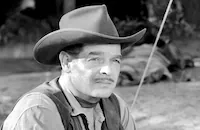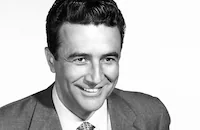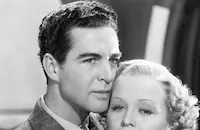Batman and Robin
Brief Synopsis
Cast & Crew
Spencer Gordon Bennet
Robert Lowery
Johnny Duncan
Jane Adams
Lyle Talbot
Ralph Graves
Film Details
Technical Specs
Synopsis
Antisocial Prof. Hammil's Remote Control device, which enables the user to take over any motor vehicle within 50 miles (!), is stolen by The Wizard, black-hooded mastermind, and his gang. Batman and Robin (who drive about in a standard convertible) must prevent the Wizard from obtaining diamonds, needed as fuel for the device, and rescue magazine photographer Vicki Vale from periodic perils. Where is the Wizard's base, reached only by remote controlled submarine? Which of several suspicious characters hides beneath the Wizard's hood?
Director
Spencer Gordon Bennet
Film Details
Technical Specs
Articles
Batman and Robin: The Complete 1949 Movie Serial Collection
Now on DVD, Batman and Robin offers more historical value than entertainment value (speaking of history, this is also known as The New Adventures of Batman and Robin, as it followed a 1943 serial that had a different cast). I'm sure there are many Batman comic-book buffs out there who get something out of the serial's 4+ hours of good versus evil, but this B-movie fan is not one of them. In order to somewhat replicate the chapter-a-week diet with which 1949 moviegoers were fed Batman and Robin, I watched a chapter a day for 15 days. It's not a diet I can recommend. As with the lack of a Batmobile, the serial is a series of gaffes, ineptitude and illogic. It's not just the bad costumes (Batman's cowl looks like it has devil horns); it's not just the scratchy stock footage whenever a vehicle plummets off a cliff; it's not just the fight scenes made up of punch sound-effects and 1940s pro wrestling moves; and it's not just the fact that Batman pulls a 25-inch blowtorch from his heretofore unused utility belt in one chapter. It's more.
What can you say about a piece of staged drama in which the evil Wizard can say to his group of feckless henchmen, "You stay here, the rest of you come with me" without any inflection or gestures to denote just who is supposed to stick around, yet somehow one guy manages to stay put? Or when Bruce Wayne's trusty butler Alfred keeps opening a door to glimpse the Bat signal in the sky, instead of just looking through a window? Or when Batman and Robin are guarding the contents of a vault, but when someone mysteriously sets off an explosion to pop the door open, they immediately run off in pursuit of, essentially, nothing and leave the opened vault unguarded? I guess you have to say that it's a miracle director Spencer Gordon Bennett worked from the 1920s through the 1960s (at least producer Sam Katzman has some interesting other credits).
Those sorts of things happen regularly in Batman and Robin, as the masked, cloaked Wizard tries to wreak havoc with the "remote control machine" he stole from a scientific research company. The machine can control any transportation vehicle within a 50-mile radius and, in between trying to fight off Batman and Robin, the heavy tries to pry $5 million ransom from the railroad industry for not shutting them down. Curiously, The Wiz forgets all about turning the machine into gain after his first attempt fails, and focuses only on fending off Batman and Robin. But the plot is hopelessly drawn out, with the henchmen's escapes from arrest almost as plentiful as Batman and Robin's close calls with death. To call Batman and Robin a cliffhanger is to be too kind, as most of these "close calls" are little more than cinematic baits-and-switches involving no great feat on the title characters' parts - like the parked plane that explodes with Batman and Robin "in it," except (as we see in the next chapter) they've merely stepped out the door before the explosion.
Although the bad guys have plenty of useful gadgets, the heroes have next to nothing, which makes you wonder just what they do in the Batcave. I mean, c'mon, they keep their costumes in a file cabinet. That's just sad! As Batman, colorless Robert Lowery comes off like a B-movie Victor Mature (isn't that redundant?) while Johnny Duncan seems to have the disposition of an evil henchman more than of Robin. Also here is Lyle Talbot, playing rather clueless Commissioner Gordon on his slide from 1930s contract player to 1950s member of Ed Wood's stock company (when he at least got to be in interestingly bad movies). The less said about Jane Adams' magazine photographer Vicky Vale, a bland damsel in distress role, the better. Just as most any attempt at thrills emerges as less than thrilling, any attempt to cultivate humor (rare) or sexual sparks between Bruce and Vicky yields little.
There is one sign of hope that maybe someone working on Batman and Robin realized how pathetic it was. During a sequence in a warehouse in a later chapter, every single box reading "this side up" is stacked upside down (there are a dozen or so). Is this some crew member's wink to the audience? Did maybe even Bennett do this? After sitting through this charmless drag, it's no wonder this serial did not lead to any follow-ups and that the makers of the next big Batman filmed project, the 1960s TV series, took a completely opposite approach to it, with color, humor and a distinct lack of earnestness. What an improvement.
But just one more question before I sign off: Do you think the Mystery Science Theater 3000 guys could come out of retirement to mercilessly heckle a chapter of this thing? Snacks are on me, fellas.
For more information about Batman and Robin: The Complete 1949 Movie Serial, visit Sony Pictures. To order Batman and Robin, go to TCM Shopping.
by Paul Sherman

Batman and Robin: The Complete 1949 Movie Serial Collection
Quotes
Trivia
Vicki Vale would become a common character in the Batman comics after this film. Bob Kane based her image on Marilyn Monroe, whom he met during the film's banquet.


















